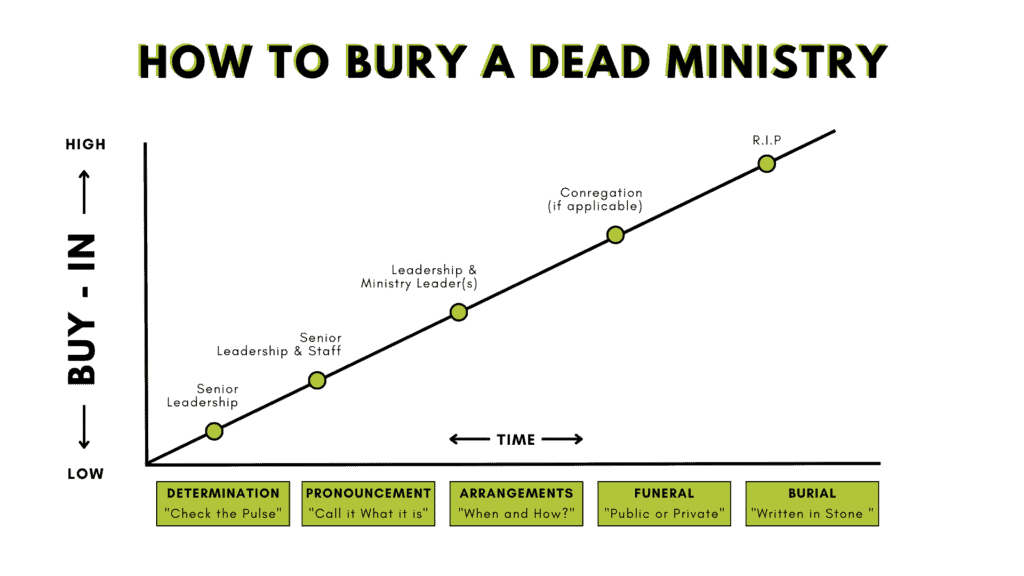At The Unstuck Group, we use several strategic planning tools that confront churches with the task of letting go of past practices or embracing new paradigms. In many cases, ending a ministry program means leading a sacred cow to the slaughter house.
Burying a ministry can result in a devastating fallout if not handled properly.
We’ve already written about the step-by-step process for determining what programs you need to stop. It basically comes down to this: In order for churches to move forward, they need to understand that ministry health must be equated to life change and spiritual growth. Programs that don’t lead to health by that definition are dead weight.
So, how do you properly bury a dead ministry program?
The Five Stages of Burial:
- Determination: Check the Pulse
A clear vision and strategy helps you determine whether or not a ministry program still has a pulse (or if it is on life support and sucking resources from something else).
- Pronouncement: Call It What It Is
This is probably the hardest part for most teams: having the courage to call it what it is. Pronouncing a ministry as dead can be painful, and if not handled right, could result in unnecessary fallout. You have to communicate that the ministry or event is no longer producing fruit as it once did.
- Arrangements: Plan for When and How
Next, the team must determine the when and how. Anytime someone passes away, the immediate family members make the arrangements. Inviting those who were “closest” to the ministry to be a part of the “when and how” discussions can be helpful, as well as help to prevent confusion and frustration. (Obviously there are exceptions to this—the leadership should pray about this and use careful discernment.)
- Funeral: Public or Private?
There are some people who arrange private funerals for family only and others arrange public funerals for family and friends. The team needs to decide what kind of funeral is needed. For example, a ministry that had high visibility in the church would probably require some sort of public statement, announcement, or even a “celebration of life” for the things it accomplished. A behind-the-scenes or smaller ministry may be handled in a more private arrangement with those closest to it.
- Burial: Write It in Stone
Once the ministry is buried, it’s written in stone, meaning, we aren’t going back there. This is imperative because when a new endeavor or new plan hits obstacles, the tendency and temptation for most churches is to go back to what “we used to do.”

Mourning and Moving on...
Regardless of how well a ministry funeral is planned, there will always be a level of grief involved. This is especially true if a ministry has been around for a lot of years, and experienced a season of booming and high visibility.
Here are some key learnings I have gathered while leading churches through this process:
Have Courage
Andy Stanley once said, “The thing that separates great leaders from good leaders is the willingness to make the hard decision.” Stay committed to the hard decision.
Lose to Gain
There will always be people who do not agree with the leadership’s decision to bury a ministry. As a result, some people will threaten to leave the church. It is important to understand that in order to gain, you sometimes have to lose. Don’t allow people to take you hostage. Sometimes losing programs means losing people.
Stay true to God, stay true to the vision and the rest will fall into place.
Celebrate Life
One of the biggest mistakes leaders make is to treat a dead ministry like it was never important.
It’s common to hear people share meaningful memories at a funeral. It seems to encourage and comfort the family who lost a loved one. Likewise, it is important to celebrate the wins of yesterday of a former ministry and allow those who were involved to share stories.
Once a ministry is buried, it’s time to let it rest in peace, meaning, it’s time to move on and see what God has next. Determine which “living” ministry can use the resources from the one that was just buried.






